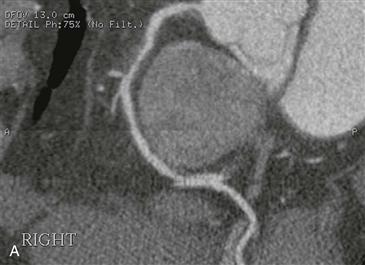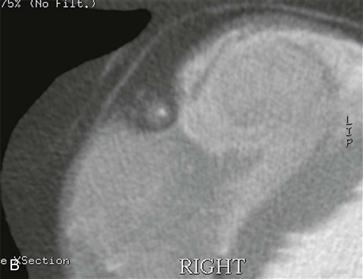CASE 19


1. What medications are often used before performing this examination? (Choose all that apply.)
B. Amiodarone
E. Angiotensin-converting enzyme inhibitor
2. Which coronary artery is most affected by cardiac motion?
C. Left main
D. Right
3. What is the finding in the right coronary artery?
A. Normal
B. Myocardial bridge with stenosis
4. Assuming the other coronary arteries were normal, what is the next best step in management?
A. Diagnostic catheter angiogram
ANSWERS
Reference
Kerl JM, Hofmann LK, Thilo C, et al. Coronary CTA: image acquisition and interpretation. J Thorac Imaging. 2007;22(1):22–34.
Cross-Reference
Cardiac Imaging: The REQUISITES, ed 3, pp 248–261.
Comment
Imaging
A multiplanar reformatted image from CT angiography shows a circumferential, focal stenosis of the proximal right coronary artery composed entirely of noncalcified plaque (Fig. A). The degree of narrowing is best appreciated on the short-axis image; the stenosis measures approximately 60% (Fig. B).
Benefits of CT Angiography
The main benefit of CT angiography is that it excludes coronary artery disease in patients presenting with chest pain. Patients with ST segment elevation, typical angina, and elevated cardiac enzymes do not require CT angiography but rather undergo emergent revascularization therapy. CT angiography is best used as a test in patients with a low or intermediate pretest probability of disease. In these patients, CT angiography has a low number of false-positive results and essentially no false-negative results. It has been shown to reduce overall cost and length of hospital stay in this patient subgroup.
Heart Rate Control
Patient preparation is an important aspect of imaging that must not be overlooked. A target heart rate less than 65 to 70 beats/min is desired to achieve motion-free images. Either intravenous or oral beta blockers may be given to achieve a target heart rate. When the patient is on the scanner table, 5 mg of intravenous metoprolol may be given. This dose can be repeated for a total dose of 15 to 25 mg. Alternatively, oral metoprolol may be given. A dose of 50 to 100 mg may be given the night before the scan, with an additional dose 30 to 60 minutes before starting the CT angiography scan. A third dose may be given if adequate rate control is not achieved. A drawback of oral dosing is the added time required to achieve adequate drug levels.
Vasodilators
Nitroglycerin is commonly administered before CT angiography at a dose of 300 to 600 micrograms sublingually 2 minutes before starting the scan. Nitroglycerin vasodilates the coronary arteries, which leads to better visualization of the arteries and may reduce coronary spasm, which is more prevalent in younger patients.







